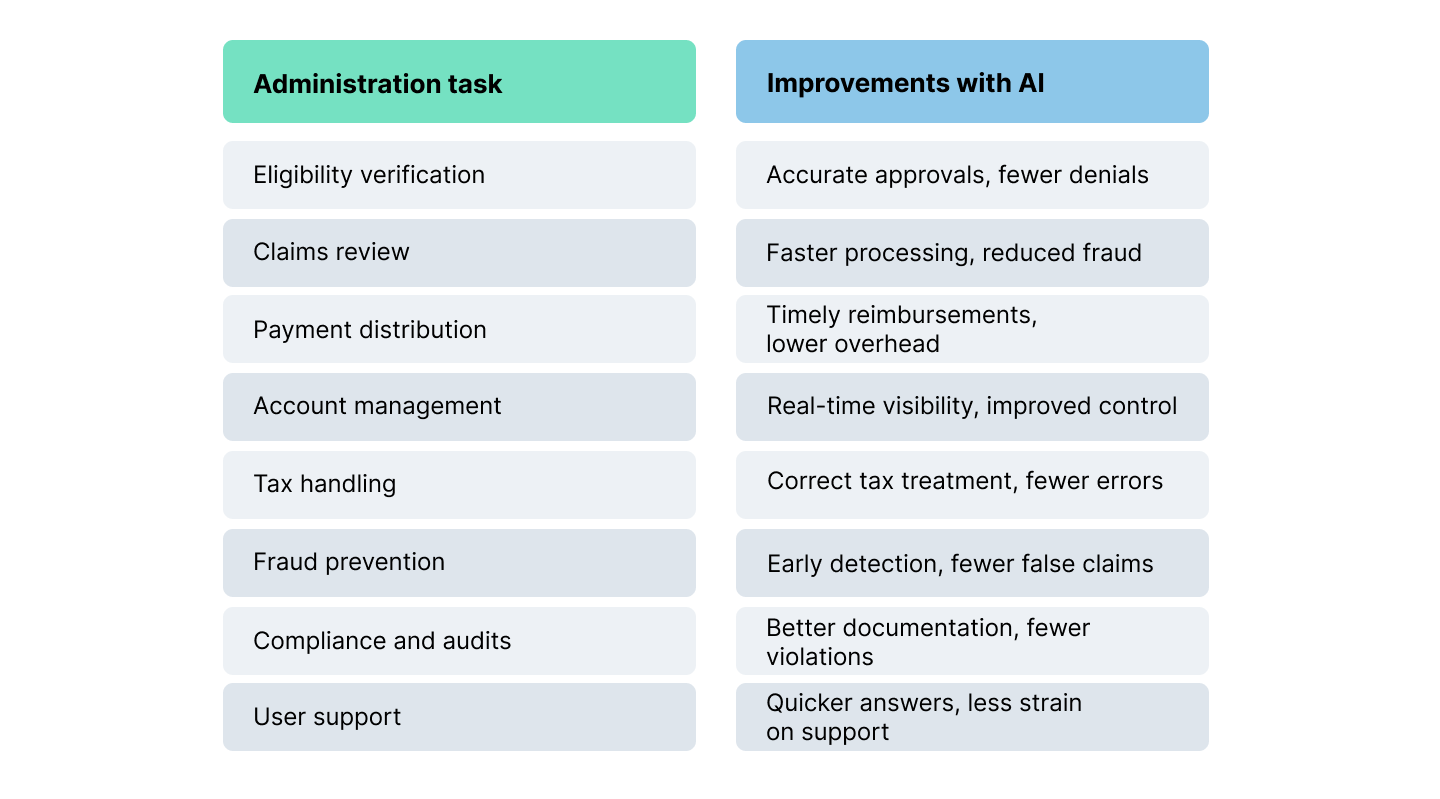Managing employee benefits used to be a manual, delay-prone process, but artificial intelligence (AI) is quietly making it faster, smarter, and more secure. For many years, benefits administrators reviewed receipts submitted for reimbursement, verified their eligibility, and entered data by hand. Prepaid cards and account-based funds — like the Healthcare Savings Account (HSA), Flexible Savings Account (FSA), and Health Reimbursement Arrangement (HRA) in the US — helped alleviate some of the headaches by funding through batch processing, but they were also hindered by manual approval and validation steps. Now, generative AI can provide real-time validation to instantly verify receipts, check eligibility, and fund benefits cards.
There are further reasons to use AI in benefits administration. AI systems generate a log for every transaction, which can be used for compliance obligations. They also apply the proper tax rate, regardless of whether funding is through post-paid reimbursement or a pre-paid card. In more sophisticated environments, AI could be used to assign a risk score to each claim or payment request. For example, an AI model could detect unusual timing, spikes in claim volume, missing metadata, poor formatting, or signs of synthetic content. If a high score raised a concern, the system could analyze receipt images for anomalies or escalate the case to a reviewer.
Savings from AI in benefits administration are substantial. AI-driven systems in benefit administration could help insurers reduce improper payments and decrease fraud-related losses by billions of dollars in the U.S. alone. It’s another reason to take a closer look at how AI is transforming benefits administration.
Why use AI in employee benefits?
AI supports every part of the benefits ecosystem by improving how payments are managed and tracked. It reduces the administrative burden for employers, provides better fraud protection for insurance companies, and makes the benefits experience smoother for employees. AI can be used to:
- Verify eligibility for benefits payments
- Automate claims processing and approval
- Flag suspicious receipts for manual review
- Route funds to HSA, FSA, and other accounts
- Issue and manage benefits cards
- Track transactions for compliance and audits
- Apply tax rules to pre- and post-paid accounts
- Learn from past claims to improve accuracy
- Speed up reimbursement timelines
- Reduce duplicate or incorrect payments
- Support HR teams
AI in HR helps human resources professionals keep up with demands. As benefits packages become more complex, AI can help evaluate and explain them. Employees want more choices of benefits that match their needs, but offering them takes even more time. That leads to another reason companies are moving to AI for benefits management: personalization. Chatbots and virtual assistants guide employees through selecting benefits, matching their situations with company insurance options.
AI improvements by task in benefits administration

Pressure to cut costs also pushes companies to adopt AI-powered benefits administration. Routine tasks such as filing take time and money. In addition to automating repetitive tasks, AI provides real-time analytics that help benefits professionals reduce error rates.
Companies with employee-centric benefits administration also do a better job of protecting data and following complex laws and regulations. Automated checks and clear records prevent minor issues from becoming major problems. By handling the details in the background, AI-powered tools take care of administrative tasks.
Modernizing benefits administration
Successful application of AI to employee benefits begins by identifying needs. Companies should set clear goals and determine where AI can deliver the most value, such as by reducing manual work, processing claims faster, or helping employees make informed decisions about benefits. It’s also essential to evaluate current HR processes and determine how the integration of AI in benefits administration might disrupt existing benefits administration workflows.
Good results depend on clean, well-structured employee data. Before introducing AI, ensure records are accurate and properly stored. Once the data is in place, companies can test AI on a small scale before rolling out broader changes. Training builds confidence and ensures everyone knows how to work with the new AI systems.
5 benefits of AI in benefits administration

Streamlining claims
AI in benefits administration can handle reviews faster than people can. AI automates the claims process, resulting in fewer delays and quicker payments for employees. Automation saves hours on repetitive tasks and lowers the chance of errors. It also gives insurers more visibility into spending trends and helps employers maintain compliance without increasing overhead.
Better decisions with data analytics
When AI and machine learning models analyze high-quality benefits data, they can uncover patterns. For instance, AI can track changes in how employees use their benefits by identifying trends, such as increased telehealth visits or rising mentalhealth claims. Companies can use that information to forecast future insurance costs and adjust their benefits strategies.
AI also fuels predictive analytics by using past data to forecast future outcomes. For example:
- IBM used AI to identify employees who were at risk of leaving with 95% accuracy. As a result, they reported saving around $300 million in retention costs and saw a 20% increase in employee engagement.
- Weave used Lattice AI to analyze survey and communication data. Based on those results, they made changes that led to a 95% increase in their employee Net Promoter Score (eNPS).
- In recent studies, large language models like OpenAI’s GPT-3.5 have outperformed traditional models in predicting which employees are likely to leave. The results of one study revealed an F1 score of approximately 0.92 for attrition prediction.
Smarter budget planning and risk management are also easier with AI tools, which can flag emerging cost spikes before they hit or identify hidden turnover trends. With AI, benefits administrators can spend less time responding to immediate issues and take a more active role in business planning.
Automating routine tasks
Many routine tasks in benefits administration can be automated by AI, from checking eligibility and processing forms to updating employee records. Using LLM capabilities and document processing techniques, systems can extract information from applications, verify data, and route documents accurately without manual review.
AI also enables personalized support, improving benefits effectiveness. Chatbot assistants can answer questions, explain coverage options, and provide tailored recommendations based on each employee’s usage history.
Improving compliance accuracy
AI is transforming compliance management. Companies using AI for benefits administration can maintain better compliance. AI systems can be programmed to track changing laws and regulations. It can then send alerts when the company needs to make updates to satisfy new regulations. AI systems also keep clear records and leave audit trails, which makes it easier to prove compliance when necessary.
By keeping track of rules and checking data, AI-powered benefits administration tools protect both companies and employees. Staying ahead of compliance also builds trust with employees.
Personalized benefits experiences
Finally, insurance companies, banks, and even employers use AI in benefits administration to get quick, personalized answers. AI chatbots and virtual assistants analyze employee data and suggest benefits options that match life stages and goals. For example, AI might remind new parents about childcare or help someone who is moving update their medical coverage. Wellness chatbots can support individuals’ mental and physical well-being. Generative AI applications can create personalized wellness tips and adjust them as needs change. In this way, AI helps employees take advantage of available benefits and shows that the company cares about them.
Addressing AI challenges
While AI-driven benefits administration can be valuable, the combination of sensitive data and AI tools can pose challenges. Because AI technology is new, companies must address data privacy, human oversight, and AI-generated bias in output before deployment.
Data privacy and security
In benefits administration, AI systems process sensitive employee data, which means people must trust the AI. A lack of trust can slow adoption or lead to backlash. Be transparent about what data is collected, why, and who has access to it. Use encryption, limit data sharing, and audit systems regularly. Addressing legitimate concerns and misconceptions early prevents confusion among employees and builds trust in an AI platform.
Human oversight
AI is efficient, but it lacks judgment. The best way to prevent AI from being seen as the decision-maker is to keep people involved. Using AI to automate routine tasks is fine, but benefits leaders still must make important decisions. They also need to handle exceptions. For example, AI might be able to automate most claims, but some will be complicated and require the attention of a specialist. Furthermore, errors can still occur, and human oversight helps maintain trust in the output.
Closing knowledge gaps
Many people hesitate to use AI because they are unfamiliar with it. That unfamiliarity often leads to low adoption or misuse. To overcome this, offer practical, role-specific training and explain exactly what AI is, along with its capabilities and limitations. Keep communication open. Create an AI champion to promote it. Once employees feel comfortable using AI, they will likely incorporate it into their workflows.
Checking for errors and bias
Even well-built AI solutions can promote bias or make mistakes, especially when they are trained on limited or poor-quality data. In addition to using high-quality training data, review AI’s work for patterns that appear concerning. When bias is caught early in an algorithm, patterns can be reversed. When left untouched, however, bias can become the dominant pattern and lead to unfair outcomes, including rejection of valid claims.
Steps to using AI-powered benefits administration
A structured approach will ensure a smoother AI rollout and better long-term results:
- Select the right AI benefits partner. Choose a software developer like Intellias with a dedicated team of engineers experienced in building systems for processing benefits and working with payment cards.
- Set clear goals. Identify how AI will be used, such as to improve the benefits enrollment experience, process claims, or check for fraud.
- Audit your data. Review records for completeness and fill in what is not there, as AI requires high-quality data for training.
- Start small. Begin with a limited rollout focused on a few repeatable tasks (such as eligibility checks, FAQ responses, or claims processing), then evaluate how well they are performing.
- Train your team. Provide practical training and clear documentation to support the team and build confidence and trust in the system.
- Monitor and refine. Use what you learn to fine-tune the system and expand to other tasks when ready.
Using AI in an employee benefits repayment system
To stay competitive, a company in the employee benefits industry wanted to create a modern SaaS solution that could process claims from FSA, HSA, HRA, and transportation accounts. These claims were usually processed manually. The company wanted a completely automated system that could process any claim with a few clicks rather than thousands.
Drawing on many years of experience developing software for the payments industry, Intellias built a benefits repayment system with a simplified workflow. The new SaaS program automatically processes every claim. It also simplifies claims management for users, allowing them to access their profile from a mobile app to view payment history, start a new claim, request a benefits refund, and link bank accounts and payment cards.
Additionally, AI models for image recognition distinguish different types of expenses and create requests to process repayments automatically. In addition to being a hands-off solution, the new cloud-based system can process repayments faster with the help of AI.
Getting started with AI in benefits
AI is becoming the central focus of benefits processing software. Companies that introduce AI first will improve the benefits experience for everyone.
Learn how Intellias engineers can humanize AI benefits management as your benefits partner. Contact us to get started with AI consulting services.


